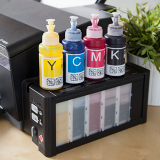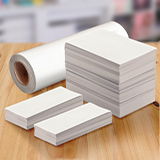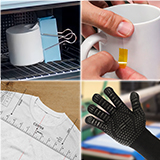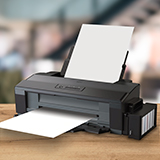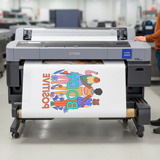1. What is sublimation?
Dye sublimation is a personalisation technique that allows you to print an image on paper, and transfer it to a garment or item that is suitable for sublimation (polyester fabrics or objects with a special polyester coating) using a heat press.
With this technique, you can add a photo to a polyester garment or to an item such as a mug, a cushion, a glass, a photo holder, etc. The process of sublimation printing is based on applying heat with a heat press on a printed design in contact with the object you are personalising. The heat will cause the sublimation ink to go directly from a solid to a gaseous state, and to penetrate the surface of the item. As a result, personalised objects are produced with images of maximum sharpness and detail, colourful and highly resistant to washing.
2. How to sublimate an item?
The sublimation process consists of the following steps:
- Prepare the image: Edit or prepare the image on your computer, and print it using an inkjet printer (intended exclusively for sublimation) that you have previously equipped with sublimation inks and paper. Generally, you will need to print it in mirror image but check it beforehand for the item you are personalising.
- Prepare the press: Start and set up the press. The sublimation process has 3 variables that you must adjust on the press: temperature, time and pressure. These variables will depend on the type of product you are sublimating and its dimensions. You may find charts with recommendations for time and temperature adjustments, but only experience will allow you to find optimal settings.
- Prepare the item: Place the printed paper against the customisable item. If you are printing on a rigid object (a mug, a photo slate, a plate, etc.), you must fix the paper with heat-resistant tape to ensure that it is well positioned and does not move.
- Place the item on the heat press: When the press reaches the set temperature, place the item on the lower plate and close it. You must wait until the time has elapsed. Applying heat and pressure will sublimate the object: the ink goes from solid to gaseous, penetrating its surface.
- Remove the item from the heat press: When the set time has elapsed, you must remove the sublimated item from the press. But you must use a protective glove because it will be very hot and you could burn yourself. Then, remove the paper carefully.
3. How to adjust time, temperature and pressure?
It is essential to adjust these 3 variables on the heat press:
- Temperature: In general, a temperature of 200ºC is recommended for all products.
- Pressure: Depending on the item, you must set the press to medium or heavy pressure. You will know that the press is correctly set because you will have to make some effort to close it.
- Time: Time will depend on the type of item you want to print and its dimensions. Here are some general recommendations:
| BLANK ITEM | TIME |
|---|---|
| Textile | 40 seconds |
| Mousepad | 25 seconds |
| Purse | 45 seconds |
| Handbag | 60 seconds |
| Cushion | 40 seconds |
| Cardboard puzzle | 40 seconds |
| Ceramic mug | 180 seconds |
FAQs:
1- What do I need to start a sublimation business?
The basic components of a sublimation system are as follows:
- A computer with design software. There are many free design programs available today.
- An inkjet printer equipped with sublimation inks and paper, so you can print your image.
- A heat press to apply, through heat, the printed image to the products you want to sublimate.
- And, of course, blank products on which you will print: textiles, caps, mugs, etc. These products require a special coating that allows the ink to be absorbed through heat.
2- Why are there so many colours for sublimation printing?
Most of the sublimation printers use 4 ink cartridges with the four basic colours CMYK (Cyan, Magenta, Yellow and Black), and from them, the entire colour spectrum is achieved. There are, however, sublimation printers with ink cartridges of other colours so that all necessary nuances can be achieved in the images to print.
3- Which printers can I use for sublimation printing?
Sublimation requires inkjet printers. The technology of these printers allows the ink to be deposited on the paper without applying heat. It is important not to apply heat to the sublimation ink when printing because it would cause sublimation (ink passes from solid to a gaseous state). We will look for this to happen in the next step when we place the item on the heat press.
4- How long does it take to sublimate a design?
It depends on the item on which you want to apply this printed design. You can check our indicative table for this information.
5- On which materials can the sublimation process be performed?
Sublimation can be applied to polymers (polyester, polyamide, etc.) or objects with a polymer coating. To achieve optimal results when sublimating fabrics, the item must be made of at least 80% polyester, although fabrics with only 65% may also be sublimated.
There is currently a very wide range of blanks that are ready for sublimation (they are polymer-coated).
However, you can also find special coatings to prepare a non-printable surface, making it suitable for sublimation printing.
6- Can I store the designs printed on sublimation paper?
The designs printed on sublimation paper can be stored as long as they remain in a place with low humidity and no exposure to the sun. However, it is preferable to print the designs when they are going to be used.
7- Can I use any kind of paper for sublimation printing?
No, you cannot. You must only use paper designed for sublimation. Paper for sublimation has specific characteristics because it acts as an ink carrier. The ink must be deposited on the paper with maximum definition, but when the heat is applied by the heat press, the paper must release the ink.
8- What is a heat press?
It is a machine, with a technology similar to that of a domestic iron, that heats its surface to a preset temperature. There are presses of many different sizes and shapes, with a flat platen, and also with cylindrical mug heaters (to personalise mugs, glasses, etc.). Any heat press machine has a way to adjust temperature, pressure and operating time, according to the item you are personalising.
The heat press applies heat and pressure against the surface of the object, which allows the transfer of the design.
9- Should I remove the sublimation paper while it is hot or cold?
The paper must be removed when cold or hot depending on the item we are personalising. For each product, you should check the specific recommendations.

